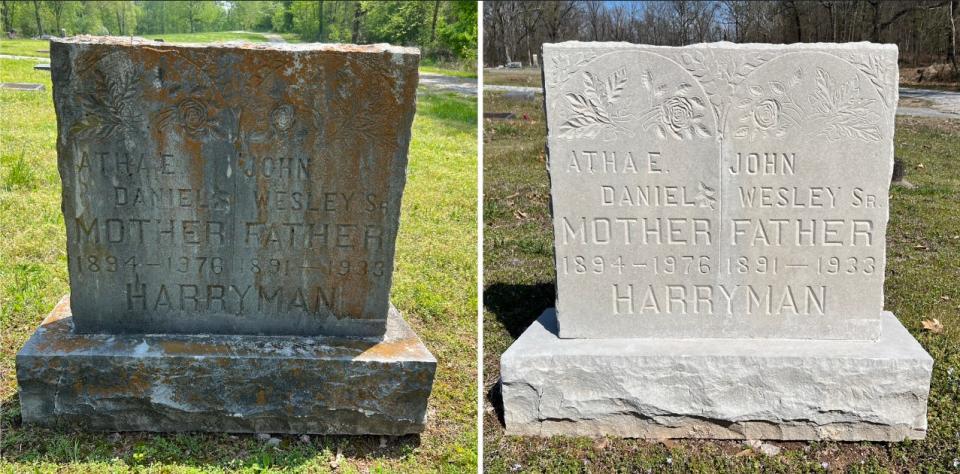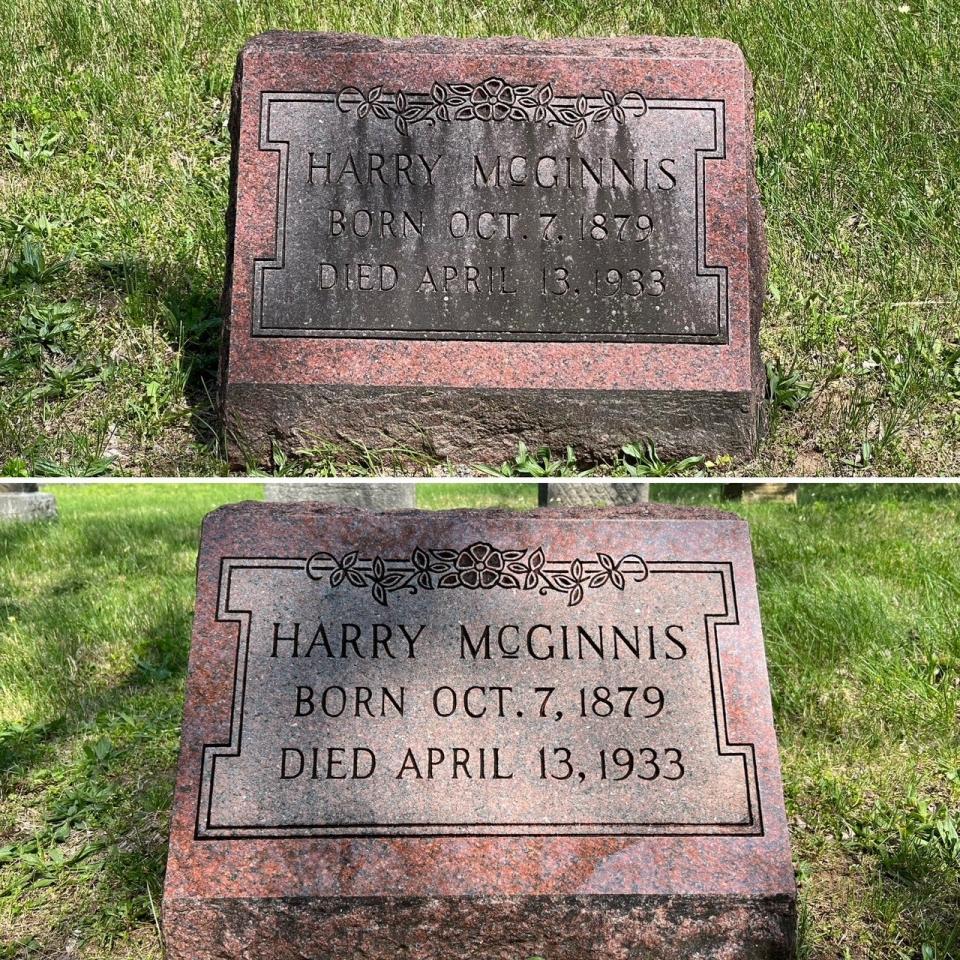Retired police officer cleans graves of men murdered by Bonnie and Clyde, 90 years later
A retired Springfield Police Department officer spent the last year cleaning two gravestones of men killed by members of the Bonnie and Clyde gang 90 years ago.
Polk County resident and retired SPD officer Ron Hutcheson said the project stemmed after he saw photos of one of the gravestones in a KY3 story about the Bonnie and Clyde murders in Joplin. The depicted gravestone was of John Wesley Harryman Sr. at Saginaw Community Cemetery in Saginaw, about an hour west of Springfield.
Hutcheson said he's been cleaning and restoring gravestones as a hobby for several years. When he saw the state of Harryman's grave, he felt compelled to clean it up.
"I just felt that this officer had been killed in the line of duty and it merited my time to restore it and make a difference," Hutcheson said. "It was just an opportunity to honor a officer that gave the ultimate sacrifice, as they say. Even though its been 90 years, it's worthy of remembering."

Harryman, known by those close to him as "Wes," died on April 13, 1933 at age 42. At the time of his death, Harryman was serving as the Joplin Police Department Constable. He died of gunshot wounds in his right shoulder and chest, according to the Missouri Law Enforcement Memorial.
This year is the 90th anniversary of the Bonnie and Clyde shootouts in Joplin. Bonnie Parker and Clyde Barrow were infamous outlaws who traveled throughout the United States with their gang, robbing banks, stores and rural funeral homes, during the Great Depression.
In April 1993, the outlaw couple spent a few weeks in a garage-style apartment on 34th Street in Joplin, robbing a few businesses. A tipped off neighbor reported the outlaws to the Joplin Police Department, but during the couple's escape, Harryman and Police Detective Harry McGinnis were killed, according to the Joplin city website.
While researching information about Harryman online, Hutcheson stumbled across contact information for Harryman's grandson, John Wesley Harryman III. Harryman III, 73, lives in Scottsdale, Arizona.
Harryman III said his father was 12 years old in 1933 when his father, Harryman Sr., was killed in the shootout. Harryman III's father was one of eight children and their mother never remarried, so many of the children had to get jobs at age 12 or 13 to help support the family without their father.
Harryman III said he never met his grandfather, but his grandmother did help raise him. It was from his older aunts and uncles that he learned about his grandfather.
When Harryman III was 18 years old, his uncle was a guest on "The Joey Bishop Show" to discuss the 1967 film, "Bonnie and Clyde."
"He went on to basically tell the world how the Bonnie and Clyde movie was not very accurate," Harryman III said. "They make Bonnie and Clyde out to be semi-heroes, very attractive people, which they were the opposite of that."
Harryman III's uncle not only had thoughts about the accuracy of the film, but he was unhappy that his father was depicted in it.
The Joplin shootout scene is featured in the film. Two police officers, who are unnamed but are likely Harryman Sr. and McGinnis, sneak up on the outlaw's apartment and are shown killed in combat. Harryman III said the movie was unfavorable for many of his family members during the heyday of its popularity.
Along with Harryman's gravestone, Hutcheson also cleaned and restored the gravestone of McGinnis at Deepwood Cemetery in Nevada, Missouri. Hutcheson said the state of this gravestone was in better condition than Harryman's, so it didn't take as long to clean.
McGinnis was also killed on April 13, 1933, at age 53. McGinnis died of a gunshot wound to his right arm, according to the Missouri Law Enforcement Memorial.

Properly cleaning and restoring gravestones is not a quick and easy process. Hutcheson said he follows the same practice used at the Arlington Cemetery in Washington D.C.
The National Cemetery Administration, under the U.S. Department of Veteran Affairs, provides an online guide for how to properly clean government-furnished gravestones and markers. The goal of cleaning is not to make a gravestone look new but instead to preserve it.
For gravestones with biological growth, like algae, mildew, moss and lichens, the National Cemetery Administration advises the use of special cleaners, like Prosoco ReVive, Cathedral Stone Bio-Cleaner, Wet and Forget or D/2 Biological Solution. Bleach and chemicals with strong acids or bases should never be used.
In addition to the proper cleaners, Hutcheson said he uses a soft brush and "lots of patience" when cleaning stones.
Hutcheson said he initially restored family gravestones but has begun working on more military gravestones. He recently gained permission from a small cemetery in Greene County and another in Polk County to begin restoring their stones too.
"It's just something that I enjoy, to be alone and the quiet, peacefulness of the rural cemeteries and also appreciate the efforts that the volunteers in these smaller cemeteries go to keep them running for their families or community," Hutcheson said.
This article originally appeared on Springfield News-Leader: Graves of men murdered by Bonnie, Clyde cleaned by retired SPD officer

